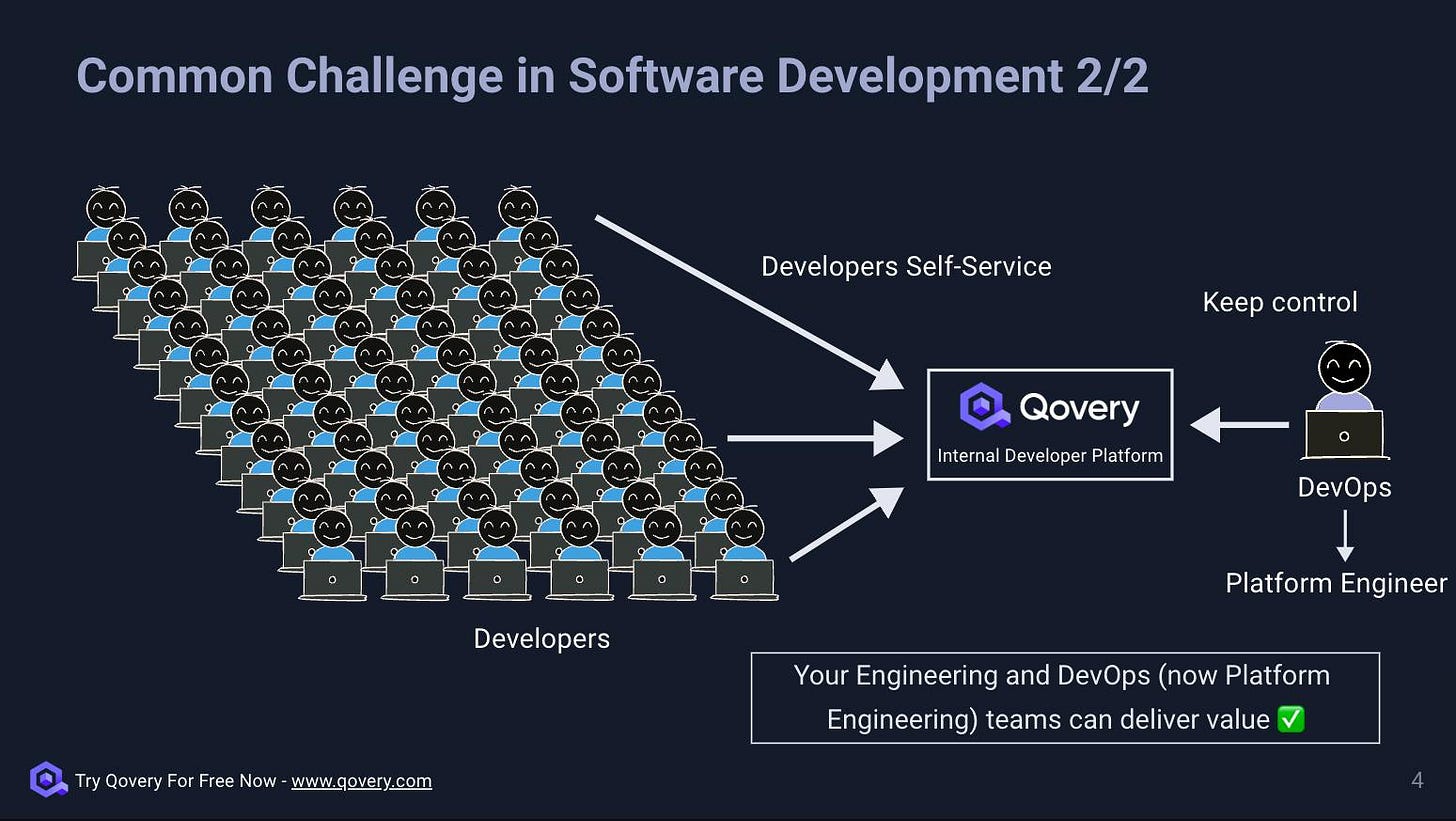Platform Engineering #7: Internal Developer Platform vs. Internal Developer Portal
Learn more about the differences and synergies about Internal Developer Platforms and Internal Developer Portals
Hey Folks 👋,
I'm Romaric Philogene, CEO and co-founder of Qovery (Internal Developer Platform), and this is my seventh post on my Substack. In my previous post, I shared my Platform Engineering predictions for 2024.
Today, I want to take some time to clarify what an Internal Developer Platform is and, what an Internal Developer Portal is, how those two platforms used by Platform Engineers can serve the same purpose - providing a self-service experience to your developers but differ from their operational scope.
TLDR;
The Internal Developer Platform acts as the engine, driving automation and integration, while the Internal Developer Portal provides the intuitive interface
Internal Developer Platform: A comprehensive suite of tools and processes enabling developers to autonomously manage the entire software lifecycle (SDLC). It integrates various development, operations, and monitoring tools into a cohesive system, facilitating DevOps practices.
Internal Developer Portal: A user-friendly interface providing developers with easy access to the tools, resources, and documentation they need. It simplifies interactions with the underlying Internal Developer Platform and other IT resources.
Synergistic Use: Using an Internal Developer Platform and an Internal Developer Portal together enhances the self-service experience. The Internal Developer Platform offers the backend muscle – process automation, integration, and functionality, while the Portal provides a streamlined, accessible front-end interface, enabling developers to leverage Internal Developer Platform functionalities more efficiently.
What is an Internal Developer Platform?
An Internal Developer Platform is an ecosystem that empowers developers to autonomously manage the entire application lifecycle from development to deployment. It emerged in response to the inefficiencies and interdependencies observed when engineering teams heavily relied on IT and DevOps for application deployment and management.
By offering a comprehensive suite of tools and services, Internal Developer Platforms enable developers to independently configure, deploy, and maintain applications, significantly enhancing efficiency and productivity.
How did we get there?
Before the advent of Internal Developer Platforms, the software development process was often crippled by delays and inefficiencies. Developers depended on external teams (IT department / DevOps engineers / SRE... it depends on the organization. I will not get into the debate here) for crucial aspects of their workflow, leading to a slower pace of development, inconsistent environments, and limited autonomy.
This is where Internal Developer Platforms come to the rescue by providing a streamlined, integrated environment that minimizes dependencies and fosters a more agile and responsive development process.
An Internal Developer Platform seamlessly integrates into the traditional DevOps and engineering stack, acting as a unifying layer that enhances and streamlines existing processes. It fits into this ecosystem by providing a centralized platform where various tools and services used in software development, deployment, and management converge. This integration allows for more efficient workflows, better resource management, and a smoother transition from development to production. By bridging the gaps between coding, testing, deployment, and infrastructure management, an Internal Developer Platform elevates the traditional stack, making it more cohesive, agile, and developer-friendly.
While Internal Developer Platforms solve one part of software developers’ issues, it does not solve all of them; this is where Internal Developer Portals come into the party too!
What is an Internal Developer Portal?
The Internal Developer Portal is the gateway to an organization's IT resources. It's the user interface where developers access tools, applications, APIs, documentation, and support. Think of it as the 'face' of your IT infrastructure – designed for ease of use and accessibility.
A well-designed Developer Portal significantly reduces the learning curve for new tools and technologies. It streamlines access to resources, facilitates collaboration, and often includes features like API catalogs, documentation libraries, and support forums.
Synergizing the Two for Enhanced Self-Service
The real magic happens when an Internal Developer Platform and an Internal Developer Portal are used in tandem. The Internal Developer Platform provides the robust backend infrastructure and automation capabilities, while the Developer Portal offers a user-friendly front-end interface. This synergy enhances the self-service experience for developers in several ways:
Simplified Access: The Portal makes it easier for developers to leverage the complex functionalities of the Internal Developer Platform without needing to delve into its intricacies.
Increased Productivity: Automated processes in the Internal Developer Platform, accessed via the Portal, reduce manual efforts and streamline development workflows.
Enhanced Collaboration: Shared resources and tools in the Portal encourage collaboration among developers, QA, and operations teams.
Better Resource Management: The Portal can provide insights and analytics from the Internal Developer Platform, helping teams optimize resource usage and performance.
So what to choose?
While an Internal Developer Platform and an Internal Developer Portal serve distinct purposes, their combined use can significantly enhance the self-service experience for developers. The Internal Developer Platform acts as the engine, driving automation and integration, while the Portal provides the intuitive interface, making these powerful capabilities readily accessible. For Platform Engineers, understanding and leveraging the strengths of both these tools is key to building a more efficient, autonomous, and developer-friendly environment.
Let's revolutionize Platform Engineering by putting developers first. Subscribe now to join me on this exciting journey!







